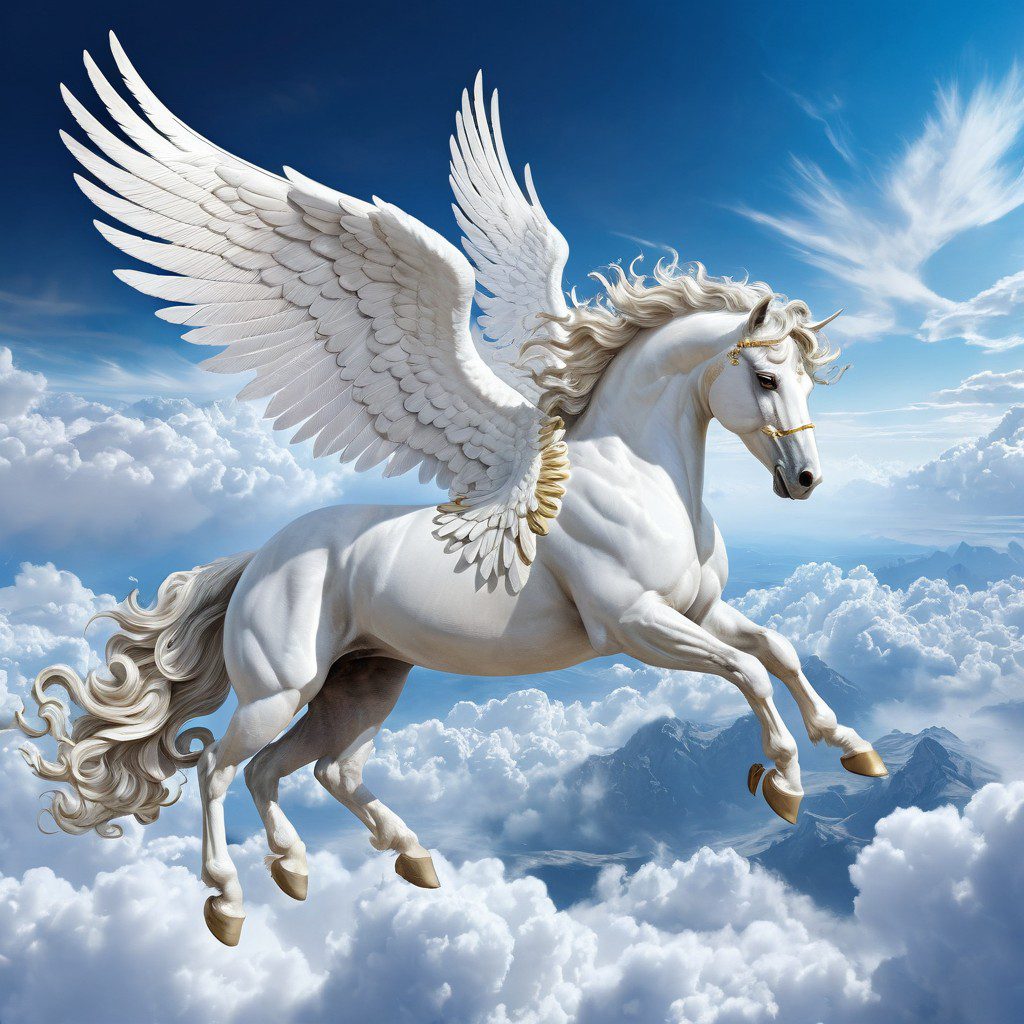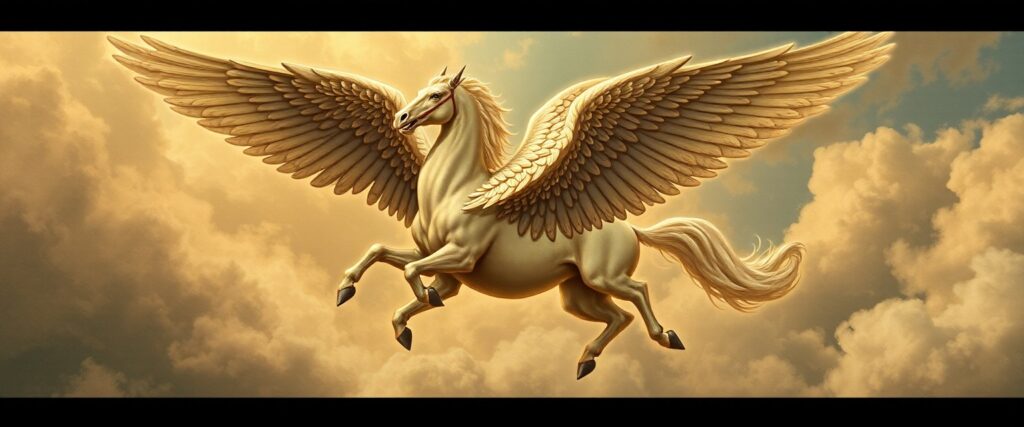Pegasus: The Winged Horse of Myth and Legend

Few mythological creatures capture the imagination quite like Pegasus, the majestic winged horse from ancient Greek mythology. Embodying both freedom and power, Pegasus is more than just a striking image from the past. His story intersects with the lives of heroes, gods, and monsters, marking him as a significant figure in the mythological landscape. But beyond his classical origins, Pegasus has galloped through the ages, appearing in literature, art, and modern media in ways that showcase his timeless appeal.
In this post, we’ll trace Pegasus’s origins, his role in classic myths, and his ongoing presence in contemporary storytelling. Along the way, we’ll highlight his most iconic strengths and some surprising weaknesses—yes, even a mythical winged horse has his limitations.
The Birth of Pegasus: Born from Blood and Seafoam
Pegasus’s origin is dramatic and otherworldly. He was born from the blood of the Gorgon Medusa when she was slain by the hero Perseus. According to one version of the myth, as Perseus beheaded Medusa, her blood spilled into the sea, mixing with the foam, from which Pegasus and his lesser-known sibling, Chrysaor, sprang. This birth scene was not just a fantastical creation but a symbolic moment, representing the emergence of beauty and grace from death and destruction. Interestingly, Pegasus’s connection to the sea is sometimes overlooked, yet it ties him to the elemental forces of nature.
After his birth, Pegasus flew to Mount Olympus, where he became the steed of the gods. But before he ascended to these heavenly heights, he had an important role to play in one of Greek mythology’s most famous monster-slaying tales.
Pegasus and Bellerophon: The Monster-Slaying Duo
Though Pegasus is most often associated with the hero Bellerophon, their partnership is far from simple. Bellerophon, a mortal hero, needed Pegasus to defeat the fearsome Chimera, a fire-breathing beast with the head of a lion, the body of a goat, and the tail of a serpent. To tame the untameable Pegasus, Bellerophon sought the help of the goddess Athena, who gifted him a golden bridle. With this divine tool, Bellerophon was able to capture Pegasus and use his speed and flight to take on the Chimera from the sky, avoiding its deadly flames and landing the killing blow.
Pegasus and Bellerophon’s teamwork would become legendary, but like many mythic tales, their partnership was doomed by hubris. After his victory over the Chimera, Bellerophon’s pride grew, and he attempted to fly Pegasus to Mount Olympus itself. Zeus, the king of the gods, saw this as an affront to the divine order and sent a gadfly to sting Pegasus, causing the horse to buck and throw Bellerophon from his back. The hero plummeted back to Earth, and his fall symbolized the fate of mortals who dared to challenge the gods.
Pegasus, however, continued his celestial journey. Freed from Bellerophon’s arrogance, he rose to the heavens and found a place in the stars. To this day, the constellation Pegasus reminds us of the winged horse’s mythic grace and enduring legacy.
Pegasus in Art and Literature: From Ancient Times to the Renaissance
In classical art and pottery, Pegasus was a popular subject, often depicted alongside Bellerophon in combat with the Chimera. The image of a winged horse soaring through the skies must have been irresistible to ancient artists, and it remains a potent symbol of imagination and freedom.
During the Renaissance, Pegasus was often used as a symbol of poetic inspiration. Renaissance poets and artists, drawing on ancient myths, saw Pegasus as a creature that could transcend earthly limitations, just as great art could elevate the human spirit. The Italian poet Ludovico Ariosto famously featured Pegasus in his epic poem Orlando Furioso, where the horse serves as a symbol of chivalric ideals and high adventure.
In the centuries that followed, Pegasus continued to appear in literature, including more modern works like C.S. Lewis’s The Chronicles of Narnia, where a Pegasus-like creature, Fledge, assists the protagonists in The Magician’s Nephew. J.K. Rowling’s Harry Potter series also makes nods to the winged horse motif, most notably with creatures like the Thestrals and Hippogriffs, both of which evoke Pegasus’s mythic flight.

Pegasus in Modern Media: Film, TV, and Games
Pegasus has made his way into contemporary pop culture in fascinating ways. One of the most well-known modern representations of Pegasus comes from Disney’s Hercules (1997), where Pegasus is a loyal, comical companion to the film’s hero. While this version of Pegasus is far more lighthearted than his classical counterpart, the core of the character remains the same: a symbol of loyalty, power, and the freedom that flight represents.
In film and TV, Pegasus has been portrayed in a variety of roles, from the majestic winged horses in Clash of the Titans to the god-like depictions in shows like Percy Jackson and the Olympians, where Pegasus and other mythic creatures take on larger-than-life qualities.
Video games, too, have embraced Pegasus. In the God of War series, Pegasus serves as a vehicle for Kratos in his journey, while games like Age of Mythology allow players to harness the creature’s flight and power in battle. Pegasus also shows up in Magic: The Gathering, where various Pegasus cards symbolize flight and protection, underscoring the creature’s long-standing association with purity and strength.
Strengths of Pegasus
- Flight and Speed: Pegasus’s most obvious strength is his ability to fly at incredible speeds. His wings grant him unmatched mobility, allowing him to soar above danger and attack from above. In battle, this made him an invaluable asset to Bellerophon.
- Divine Heritage: As a creature born of the gods, Pegasus carries with him a touch of the divine. This heritage not only grants him immortality but also makes him a symbol of the connection between the mortal and the divine realms.
- Loyalty: Though not often emphasized, Pegasus shows loyalty to those who treat him with respect. His bond with Bellerophon, at least initially, is one of mutual trust, and later he serves the gods of Olympus with dedication.
Weaknesses of Pegasus
- Susceptibility to Hubris: While Pegasus himself is not guilty of arrogance, he has been involved in the downfall of those who try to use him for personal gain. Bellerophon’s tragic end is a prime example of how mortals who overreach can suffer disastrous consequences.
- Reluctance to Bond with Mortals: Pegasus is not easily tamed. Only with Athena’s help was Bellerophon able to control him, and the need for divine intervention highlights how distant this creature is from the mortal realm.
- Vulnerability to Trickery: Pegasus was tricked by Zeus’s gadfly in the story of Bellerophon’s fall. This moment reveals that, despite his power, Pegasus is still vulnerable to manipulation by higher powers.
Conclusion: Pegasus, A Timeless Symbol
From his bloody and dramatic birth to his place among the stars, Pegasus remains one of mythology’s most fascinating figures. He represents not only physical power and freedom but also the peril of human ambition and the thin line between the mortal and divine worlds. Whether as a literary symbol of artistic inspiration or as a heroic companion in modern media, Pegasus continues to inspire and captivate.
In many ways, Pegasus is more than just a horse with wings; he’s a bridge between worlds, an embodiment of humanity’s desire to transcend its limits, and a cautionary figure about the dangers of overreach. Even today, as we look to the stars or watch him soar across our screens, Pegasus invites us to dream—though perhaps, like Bellerophon, we should be careful about how high we fly.
